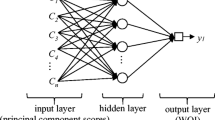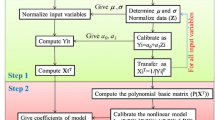Abstract
This paper proposes multilayer perceptron neural network (MLPNN) to predict phycocyanin (PC) pigment using water quality variables as predictor. In the proposed model, four water quality variables that are water temperature, dissolved oxygen, pH, and specific conductance were selected as the inputs for the MLPNN model, and the PC as the output. To demonstrate the capability and the usefulness of the MLPNN model, a total of 15,849 data measured at 15-min (15 min) intervals of time are used for the development of the model. The data are collected at the lower Charles River buoy, and available from the US Environmental Protection Agency (USEPA). For comparison purposes, a multiple linear regression (MLR) model that was frequently used for predicting water quality variables in previous studies is also built. The performances of the models are evaluated using a set of widely used statistical indices. The performance of the MLPNN and MLR models is compared with the measured data. The obtained results show that (i) the all proposed MLPNN models are more accurate than the MLR models and (ii) the results obtained are very promising and encouraging for the development of phycocyanin-predictive models.





Similar content being viewed by others
References
Abrahart RJ, Anctil F, Coulibaly P, Dawson CW, Mount NJ, See LM, Shamseldin AY, Solomatine DP, Toth E, Wilby RL (2012) Two decades of anarchy? Emerging themes and outstanding challenges for neural network river forecasting. Prog Phys Geogr 36:480–513. doi:10.1177/0309133312444943
Atkinson PM, Tatnall A (1997) Introduction neural networks in remote sensing. Int J Remote Sens 18:699–709. doi:10.1080/014311697218700
Baxter CW, Stanley SJ, Zhang Q, Smith DW (2000) Developing artificial neural network process models: a guide for drinking water utilities. In 6th Environmental Engineering Society Specialty Conference of the CSCE, vol 376–383
Berg M, Sutula M (2015) Factors affecting the growth of cyanobacteria with special emphasis on the Sacramento-San Joaquin Delta. Southern California Coastal Water Research Project Technical Report 869 August 2015
Bowden GJ, Maier HR, Dandy GC (2002) Optimal division of data for neural network models in water resources applications. Water Resour Res 38(2):1010. doi:10.1029/2001WR000266
Bowden GJ, Dandy GC, Maier HR (2003) Data transformation for neural network models in water resources applications. J Hydroinf 5(4):245–258
Bowden GJ, Nixon JB, Dandy GC, Maier HR, Holmes M (2006) Forecasting chlorine residuals in a water distribution system using a general regression neural network. Math Comput Model 44:469–484. doi:10.1016/j.mcm.2006.01.006
Brient L, Lengronne M, Bertrand E, Rolland D, Sipel A, Steinmann D, Baudin I, Legeas M, Le Rouzic B, Bormans M (2008) A phycocyanin probe as a tool for monitoring cyanobacteria in freshwater bodies. J Environ Monit 10(2):248–255. doi:10.1039/b714238b
Chai T, Draxler RR (2014) Root mean square error (RMSE) or mean absolute error (MAE)? Arguments against avoiding RMSE in the literature. Geosci Model Dev 7:1247–1250. doi:10.5194/gmd-7-1247-2014
Chorus I, Bartram J (1999) Toxic cyanobacteria in water: a guide to their public health consequences, monitoring and management. WHO F & FN Spon 11 New Fetter Lane, London EC4) 4EE. www.who.int/water_sanitation_health/resourcesquality/toxcyanbegin.pdf
Dawson CW, Wilby RL (2001) Hydrological modelling using artificial neural networks. Prog Phys Geogr 25(1):80–108. doi:10.1177/030913330102500104
Dawson CW, Harpham C, Wilby RL, Chen Y (2002) Evaluation of artificial neural network techniques for flow forecasting in the River Yangtze, China. Hydrol Earth Syst Sci 6:619–626. doi:10.5194/hess-6-619-2002
Demuth H, Beale M, Hagan M (2009) Neural network toolbox user’s guide. MathWorks, Natick, MA, p 849
Francy DS, Graham JL, Stelzer EA, Ecker CD, Brady AMG, Struffolino P, Loftin KA (2015) Water quality, cyanobacteria, and environmental factors and their relations to microcystin concentrations for use in predictive models at Ohio Lake Erie and Inland Lake Recreational Sites, 2013–14. U.S. Geological Survey Scientific Investigations Report 2015–5120, 58 p, 2 appendixes, doi:10.3133/sir20155120
Garson GD (1991) Interpreting neural-network connection weights. Artif Intell Expert 6:47–51
Gebremariam SY, Martin JF, DeMarchi C, Bosch NS, Confesor R, Ludsin SA (2014) A comprehensive approach to evaluating watershed models for predicting river flow regimes critical to downstream ecosystem services. Environ Model Softw 61:121–134. doi:10.1016/j.envsoft.2014.07.004
Gevrey M, Dimopoulos I, Lek S (2003) Review and comparison of methods to study the contribution of variables in artificial neural network models. Ecol Model 160:249–264. doi:10.1016/S0304-3800(02)00257
Hambrook Berkman JA, Canova, MG (2007) Algal biomass indicators (ver. 1.0): U.S. geological survey techniques of water-resources investigations, book 9, chap. A7, section 7.4. http://pubs.water.usgs.gov/twri9A/
Hanrahan G (2011) Artificial neural networks in biological and environmental analysis. Analytical chemistry series. CRC press Taylor Francis group, 210 pp
Haykin S (1999) Neural networks a comprehensive foundation. Prentice Hall, Upper Saddle River
Heddam S (2014) Modelling hourly dissolved oxygen concentration (DO) using dynamic evolving neural-fuzzy inference system (DENFIS) based approach: case study of Klamath river at miller island boat ramp, Oregon, USA. Environ Sci Pollut Res 21:9212–9227. doi:10.1007/s11356-014-2842-7
Heddam S (2016) Secchi disk depth estimation from water quality parameters: artificial neural network versus multiple linear regression models? Environ Process. doi:10.1007/s40710-016-0144-4
Heddam S, Bermad A, Dechemi N (2012) ANFIS-based modelling for coagulant dosage in drinking water treatment plant: a case study. Environ Monit Assess 184:1953–1971. doi:10.1007/s10661-011-2091-x
Heddam S, Lamda H, Filali S (2016) Predicting effluent biochemical oxygen demand in a wastewater treatment plant using generalized regression neural network based approach: a comparative study. Environ Process 3(1):153–165. doi:10.1007/s40710-016-0129-3
Hornik K (1991) Approximation capabilities of multilayer feedforward networks. Neural Netw 4(2):251–257. doi:10.1016/0893-6080(91)90009-T
Hornik K, Stinchcombe M, White H (1989) Multilayer feedforward networks are universal approximators. Neural Netw 2:359–366. doi:10.1016/0893-6080(89)90020-8
Hyenstrand P, Blomqvist P, Pettersson A (1998) Factors determining cyanobacterial success in aquatic systems: a literature review. Archiv Fur Hydrobiologie Special Issues: Advances in 51: 41–62
Jacoby JM, Collier DC, Welch EB, Hardy J, Crayton M (2000) Environmental factors associated with a toxic bloom of Microcystis aeruginosa. Can J Fish Aquat Sci 57:231–240. doi:10.1139/f99-234
Jin X, Du J, Liu H, Wang Z, Song K (2016) Remote estimation of soil organic matter content in the Sanjiang Plain, Northest China: the optimal band algorithm versus the GRA-ANN model. Agric For Meteorol 218–219:250–260. doi:10.1016/j.agrformet.2015.12.062
Journey CA, Beaulieu KM, Bradley PM (2013) Environmental Factors that Influence Cyanobacteria and Geosmin Occurrence in Reservoirs. In: Bradley PM (ed) Current perspectives in contaminant hydrology and water resources sustainability, 1st edn. Intech, Rijeka, Croatia, pp 27–55. doi:10.5772/54807
Kenneth Hudnell H (2008) Cyanobacterial harmful algal blooms: state of the science and research needs. Advances in Experimental Medicine and Biology, pp 950. Springer-Verlag New York. doi:10.1007/978-0-387-75865-7
Kingston GB, Maier HR, Lambert MF (2005) Calibration and validation of neural networks to ensure physically plausible hydrological modeling. J Hydrol 314:158–176. doi:10.1016/j.jhydrol.2005.03.013
Kotak BG, Lam AKY, Prepas EE, Kenefick SL, Hrudey SE (1995) Variability of the hepatoxin microcystin-LR in hypereutrophic drinking water lakes. J Phycol 31:248–263. doi:10.1111/j.0022-3646.1995.00248.x
Kotak BG, Zurawell RW, Prepas EE, Holmes CF (1996) Microcystin-LR concentration in aquatic food web compartments from lakes of varying trophic status. Can J Fish Aquat Sci 53:1974–1985. doi:10.1139/f96-135
Kuo J, Hsieh M, Lung W, She N (2007) Using artificial neural network for reservoir eutrophication prediction. Ecol Model 200:171–177. doi:10.1016/j.ecolmodel.2006.06.018
Le CF, Li YM, Zha Y, Sun DY (2009) Specific absorption coefficient and the phytoplankton package effect in Lake Taihu, China. Hydrobiologia 619:27–37. doi:10.1007/s10750-008-9579-6
Le CF, Li YM, Zha Y, Wang Q, Zhang H, Yin B (2011) Remote sensing of phycocyanin pigment in highly turbid inland waters in Lake Taihu, China. Int J Remote Sens 32(23):8253–8269. doi:10.1080/01431161.2010.533210
Legates DR, McCabe GJ (1999) Evaluating the use of “goodness of fit” measures in hydrologic and hydroclimatic model validation. Water Resour Res 35:233–241. doi:10.1029/1998WR900018
Li L, Sengpiel RE, Pascual DL, Tedesco LP, Wilson JS, Soyeux E (2010) Using hyperspectral remote sensing to estimate chlorophyll‐a and phycocyanin in a mesotrophic reservoir. Int J Remote Sens 31(15):4147–4162. doi:10.1080/01431161003789549
MacColl R (1998) Cyanobacterial phycobilisomes. J Struct Biol 124:311–334. doi:10.1006/jsbi.1998.4062
Maier HR, Dandy GC (1996) The use of artificial neural networks for the prediction of water quality parameters. Water Resour Res 32(4):1013–1022. doi:10.1029/96WR03529
Maier HR, Dandy GC, Burch MD (1998) Use of artificial neural networks for modelling cyanobacteria Anabaena spp. in the River Murray, South Australia. Ecol Model 105:257–272. doi:10.1016/S0304-3800(97)00161-0
Maier HR, Sayed T, Lence BJ (2001) Forecasting cyanobacterium Anabaena spp. in the River Murray, South Australia, using B-spline neurofuzzy models. Ecol Model 146:85–96. doi:10.1016/S0304-3800(01)00298-8
Maier HR, Jain A, Dandy GC, Sudheer KP (2010) Methods used for the development of neural networks for the prediction of water resource variables in river systems: current status and future directions. Environ Model Softw 25(8):891–909. doi:10.1016/j.envsoft.2010.02.003
Masters T (1993) Practical neural network recipes in C+ +. Academic, San Diego, 493
Mille DF, Baker MC, Tucker CD, Vinyard BT, Dionigi CP (1992) High resolution airborne remote sensing of bloom-forming phytoplankton. J Phycol 28:281–290. doi:10.1111/j.0022-3646.1992.00281.x
Moriasi DN, Arnold JG, Van Liew MW, Bingner RL, Harmel RD, Veith TL (2007) Model evaluation guidelines for systematic quantification of accuracy in watershed simulations. Trans ASABE 50(3):885–900
Nash JE, Sutcliffe JV (1970) River flow forecasting through conceptual models part 1—a discussion of principles. J Hydrol 10:282–290. doi:10.1016/0022-1694(70)90255-6
Olden JD, Jackson DA (2002) Illuminating the “black box”: understanding variable contributions in artificial neural networks. Ecol Model 154:135–150. doi:10.1016/S0304-3800(02)00064-9
Olden JD, Joy MK, Death RG (2004) An accurate comparison of methods for quantifying variable importance in artificial neural networks using simulated data. Ecol Model 178:389–397. doi:10.1016/j.ecolmodel.2004.03.013
Puzyn T, Mostrag-Szlichtyng A, Gajewicz A, Skrzyński M, Worth A (2011) Investigating the influence of data splitting on the predictive ability of QSAR/QSPR models. Struct Chem 22:795–804. doi:10.1007/s11224-011-9757-4
Rinta-Kanto JM, Konopko EA, DeBruyn JM, Bourbonniere RA, Boyer GL et al (2009) Lake Erie microcystis: relationship between microcystin production, dynamics of genotypes and environmental parameters in a large lake. Harmful Algae 8:665–673. doi:10.1016/j.hal.2008.12.004
Rumelhart DE, Hinton GE, Williams RJ (1986) Learning internal representations by error propagation. In: Rumelhart DE, McClelland PDP, Research Group (eds) Parallel distributed processing: explorations in the microstructure of cognition. Foundations, vol I. Cambridge, MA, MIT Press, p 318–62
Schalles JF, Yacobi YZ (2000) Remote detection and seasonal patterns of phycocyanin, carotenoid, and chlorophyll pigments in eutrophic waters. Arch Hydrobiol Spec Issues Adv Limnol 55:153–168
Simis SGH, Peters SWM, Gons HJ (2005) Remote sensing of the cyanobacterial pigment phycocyanin in turbid inland water. Limnol Oceanogr 50(1):237–245. doi:10.4319/lo.2005.50.1.0237
Sun D, Li Y, Wang Q, Le C, Lv H, Huang C, Gong S (2012) A novel support vector regression model to estimate the phycocyanin concentration in turbid inland waters from hyperspectral reflectance. Hydrobiologia 680:199–217. doi:10.1007/s10750-011-0918-7
USEPA United States Environmental Protection Agency (2015) Live water quality data for the Lower Charles River. www.epa.gov/charlesriver/
Wicks RJ, Thiel PG (1990) Environmental factors affecting the production of peptide toxins in floating scums of the cyanobacterium Microcystis aeruginosa in a hypertrophic African reservoir. Environ Sci Technol 24:1413–1418
Willmott CJ (1982) Some comments on the evaluation of model performance. Bull Am Meteorol Soc 63:1309–1313. doi:10.1175/1520-0477(1982)063
Willmott CJ, Ackleson SG, Davis RE, Feddema JJ, Klink KM, Legates DR, O’Donnell J, Rowe CM (1985) Statistics for the evaluation and comparison of models. J Geophys Res 90:8995–9005. doi:10.1029/JC090iC05p08995
Wynne TT, Stumpf RP, Tomlinson M, Warner RA, Tester PA, Dyble JJ, Fahnenstiel GL (2008) Relating spectral shape to cyanobacterial blooms in the Laurentian Great Lakes. Int J Remote Sens 29(12):3665–3672. doi:10.1080/01431160802007640
Zoveidavianpoor M, Samsuri A, Shadizadeh SR (2013) Adaptive neuro fuzzy inference system for compressional wave velocity prediction in a carbonate reservoir. J Appl Geophys 89:96–107. doi:10.1016/j.jappgeo.2012.11.010
Acknowledgments
We would like to thank Paul Wintrob (US EPA, Region 1, Boston) and Bill Walsh-Rogalski (USEPA Charles River) and all EPA scientists and water quality managers from Charles Rivers buoy, for allowing permission for using the data that made this study possible. Once again, we would like to thank the anonymous reviewers and the editor of Environmental Science and Pollution Research for their invaluable comments and suggestions on the contents of the manuscript which significantly improved the quality of the paper.
Author information
Authors and Affiliations
Corresponding author
Additional information
Responsible editor: Marcus Schulz
Rights and permissions
About this article
Cite this article
Heddam, S. Multilayer perceptron neural network-based approach for modeling phycocyanin pigment concentrations: case study from lower Charles River buoy, USA. Environ Sci Pollut Res 23, 17210–17225 (2016). https://doi.org/10.1007/s11356-016-6905-9
Received:
Accepted:
Published:
Issue Date:
DOI: https://doi.org/10.1007/s11356-016-6905-9




